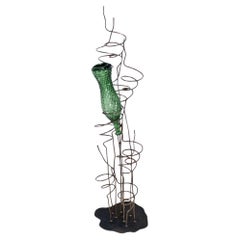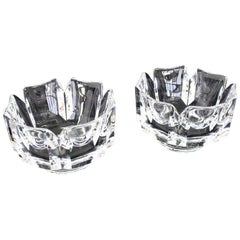Soho Treasures Barware
3
to
3
3
3
3
3
3
1
2
1
1
1
1
3
3
1
Wrought Iron Sculptural Wine Tree Rack
By John Risley
Located in Rockaway, NJ
Very unusual arts & crafts wine tree sculpture rack.
Category
Late 20th Century American Mid-Century Modern Barware
Materials
Wire
Milo Baughman Decor Burl Walnut & Chrome Mid-Century Modern Liquor Serving Bar
By Milo Baughman
Located in Rockaway, NJ
Mio Baughman decor burl walnut & chrome Mid-Century Modern liquor serving bar.
Category
20th Century American Mid-Century Modern Barware
Materials
Chrome
Pair of Heavy Crystal Bowl Vases by Orrefors
By Orrefors
Located in Rockaway, NJ
Pair of fine crystal vases bowls by Orrefors of Sweden.
Category
20th Century American Mid-Century Modern Barware
Related Items
Large Swedish Art Glass Crystal Vase by Strombergshyttan, Signed & Numbered
By Stromberg Hytten
Located in Haddonfield, NJ
Swedish handcrafted art glass with engraved deer design. Signed Stromberg and B9106027
Strombergshyttan began productions in 1933, and continued operations until early 1970's when O...
Category
Mid-20th Century Swedish Mid-Century Modern Vases
Materials
Crystal
H 8.6 in W 6.9 in D 3.8 in
Mid Century Italian Carafe Glass Liquor Bar Set Tray
Located in Saarbruecken, DE
Stylish bar set consisting of a decanter with six glasses and a tray. Italian glass from Cristallerie Artistiche DEP in a noble blue gold decor and a silver-plated tray with golden f...
Category
Late 20th Century Italian Mid-Century Modern Barware
Materials
Glass
Illuminating Lucite Bar Designed by Luigi Bardini with Ensuite Bar Stools
By Hill Manufacturing, Luigi Bardini
Located in Saint Louis, MO
Illuminating Lucite bar designed by Luigi Bardini for Hill Manufacturing and offered with en suite Lucite and chrome bar stools. Top with lamin...
Category
Vintage 1970s American Hollywood Regency Dry Bars
Materials
Lucite
H 41.5 in W 52 in D 17.5 in
Art Deco Blonde Bird's-Eye Maple Cocktail Cabinet Dry Bar, English, circa 1930s
Located in Devon, England
This hugely stylish Art Deco cocktail drinks cabinet is a fantastic piece of Art Deco furniture and it's internal features prove to be an incredibly appealing feature. The beautifull...
Category
Mid-20th Century English Art Deco Dry Bars
Materials
Mirror, Bakelite, Birdseye Maple
H 47.25 in W 30.71 in D 16.54 in
Midcentury Wine Racks by Dean Santner
By Dean Santner
Located in BROOKLYN, NY
For your consideration are these beautifully sculpted wine racks by Master Craftsman Dean Santner. Santner designs are part of the American Modern Craft movement ...
Category
Mid-20th Century American Mid-Century Modern Wine Coolers
Materials
Wood
Art Deco Walnut Cocktail Cabinet, Dry Bar, English, circa 1930
Located in Devon, England
Gorgeous and original 1930s Art Deco cocktail cabinet in figured walnut. This cabinet really is stunning, featuring a storage area for bottles at the bottom and glasses etc. at the t...
Category
Mid-20th Century English Art Deco Dry Bars
Materials
Glass, Mirror, Bakelite, Walnut
Vintage Mid-Century Orrefors Crystal Decanter with Stopper
By Orrefors
Located in Soquel, CA
Elegant Mid-Century Modern vintage crystal decanter with stopper by Orrefors (Swedish, founded 1898), c. 1960's. Engraved signature to base Orrefors HM 2498 - this particular style was by Edvard Hall.
Includes original red Orrefors Sweden sticker with logo.
"Orrefors HM 2498" etched into base.
Measures 11.5" H x 3" W x 3" D.
Orrefors Glassworks was founded in 1898 on the same site where ironworks operations had been run since 1726. In the same year that the glassworks was founded, a hot shop was built for making technical, medical and household glass and stemware to make use of waste wood and labour. Glass now replaced the less profitable ironworks operations.
In 1913, Consul Johan Ekman from Gothenburg became the new owner of Orrefors Glassworks. He appointed Albert Ahlin as manager of the glassworks and this marked the start of a new era. In 1914, Orrefors started manufacturing crystal products, and as well as cut crystal according to purchased patterns and samples, Orrefors made art glass using the overlay technique with etched decoration. The new management quickly saw that artists were needed in the business, so Simon Gate was employed in 1916 and was joined by Edward Hald a year later.
That same year, Gate and Hald made their first tentative attempts at figure engraving. They also experimented with the new innovative graal (grail) glass technique that was developed at Orrefors by the master glassblower Knut Bergqvist. The major successes were achieved a few years later at the Gothenburg Exhibition in 1923, and in particular at the Paris Exhibition in 1925. The thin engraved glass was admired by the surrounding world, and both Orrefors and the artists themselves were awarded the Grand Prix.
The successes of Simon Gate and Edward Hald in Paris in 1925 constituted the start of the long Orrefors tradition of creative design closely combined with genuine and innovative craftsmanship.
Since then, new designers and skilled glassmakers have continued in the spirit of Gate and Hald. Vicke Lindstrand and Edvin Öhrström with the new glass technique called Ariel in the 1930s. Sven Palmqvist with Kraka and Ravenna in the 1940s. And in the 1950s with Fuga, which, along with Nils Landberg’s slender tulip-shaped glass “Tulpan” and Ingeborg Lundin’s apple-shaped vase “Äpplet”, are now seen as symbols of the renaissance of Swedish design. The 1960s are associated with Gunnar Cyrén’s Pop glass, and in the 1970s, Eva Englund, Olle Alberius, Lars Hellsten and Jan Johansson as well as Cyrén worked at the glassworks.
Since the 1980s, designers such as Anne Nilsson, Erika Lagerbielke, Helen Krantz, Matz Borgström, Per B Sundberg, Martti Rytkönen, Lena Bergström, Ingegerd Råman, Malin Lindahl and Efva Attling...
Category
Mid-20th Century Swedish Mid-Century Modern Bottles
Materials
Crystal
1960's Swedish Crystal Vase by Orrefors
By Orrefors
Located in Paris, FR
20th-century vintage modernist crystal vase signed by Swedish makers Orrefors. This chic statement decorative piece is highlighted by its modern design and thick curved cut.
Signed ...
Category
20th Century Swedish Modern Vases
Materials
Crystal
Very Heavy Pair of Wrought Iron Vintage Bookends
By AIREDELSUR
Located in Buenos Aires, AR
Very heavy pair of wrought iron vintage bookends.
Category
20th Century Italian Art Nouveau Barware
Materials
Harewood
Wine Rack Made in Tropical Wood
Located in Mexico City, CDMX
This amazing wine rack are made of a mix of tropical woods. The rack holds eleven wine bottles and can be completely disassembled.
Category
2010s Mexican Mid-Century Modern Wine Coolers
Materials
Mahogany
Pair of Hand Etched Crystal Decanters
Located in Vilnius, LT
Pair of hand etched and cut crystal decanters mounted with silver plated necks.
Labeled.
Category
Late 20th Century Czech Crystal Serveware
Materials
Crystal, Metal
Willy Rizzo Midcentury Cubic Chromed Steel, Wood and Glass Dry Bar, Italy 1970s
By Willy Rizzo
Located in Roma, IT
Unique midcentury cubic dry bar in lacquered ash wood, mirrored steel and glass dry bar with hidden wheels. Willy Rizzo probably produced this incredible piece of barware in Italy during the 1970s.
The wheeled bar cart's four sides are in mirrored chromed steel, while the top is in dark smoked glass. It moves thanks to four hidden wheels, and the structure is veneered black lacquered oak.
A design masterpiece that will become a cult furniture element in a midcentury bar or living room.
Italian designer and photographer Willy Rizzo (1928-2013) first came to prominence in the 1960s as both a chronicler of and participant in La Dolce Vita, the glamorous, jet set lifestyle enjoyed by many international celebrities and socialites in the postwar era. While photography was Rizzo's first love, in the 1970s he developed a passion for interiors and launched a second successful career as a luxury furniture designer.
Rizzo was born in Naples in 1928 but moved to France early. After expressing an interest in photography at the age of 12, Rizzo's mother gifted him an Agfa Box camera; soon he was shooting portraits of his classmates at Paris's Istituto Statale Italiano Leonardo Da Vinci.
In the 1940s, Rizzo began his career as a photojournalist, working for several French publications, including Ciné Mondial, Point de Vue, and Image du Monde. In the aftermath of the Second World War, Rizzo notably covered the Nuremberg Trials and travelled to Tunisia for Point de Vue to photograph the conflict in North Africa, later published in Life Magazine. As his reputation grew, he was hired by France Dimanche to take portraits of the rich and famous at flashy events like the Cannes Film Festival. Rizzo's charm won the trust of royalty, dignitaries, and movie stars, allowing him to capture these public figures in unusually candid moments.
Hoping to advance his career further, Rizzo travelled to New York with Black Star Agency in 1947 to photograph American starlets. When he returned to Paris two years later, he was invited to join Jean Prouvost’s newest publication in colour, Paris Match, as head photographer—a position that he held for 20 years and, along the way, sparked a new culture of celebrity photographers who were as intriguing and fashionable as their subjects.
In 1959, he became the artistic director of Marie Claire and collaborated with other fashion magazines, such as Vogue.
Throughout his career, Rizzo photographed dozens of stars, including Brigitte Bardot, Maria Callas, Salvador Dalí, Marlene Dietrich, Jane Fonda, Gene Kelly, and Gregory Peck, as well as striking up close friendships with famous personalities like Coco Chanel, Christian Dior, and Jack Nicholson. In 1962, Rizzo famously captured some of the last moments of Marilyn Monroe’s life on film before tragically committing suicide a few weeks later.
In 1968, Rizzo married Italian actress Elsa Martinelli, and the pair relocated to Rome. It was here that Rizzo began his work in furniture design, starting with his newly-leased, run-down Roman apartment. Just for personal use (at first), Rizzo created a series one-of-a-kind pieces inspired by modernist icons, such as Mies van der Rohe and Le Corbusier. But as his glitterati friends—Rodolfo Parisi, Gigli Rizzi, Franco Rapetti, Salvador Dalí, Brigitte Bardot, and the like—became admirers of his work, Rizzo was flooded with design commissions.
Rizzo went on to furnish apartments for Italian aristocracy in the Palazzo Borghese and Palazzo Ruspoli that same year and quickly earned an international reputation as a designer to the rich and famous. In response to ever-growing demand, he launched his own Tivoli-based company dedicated to contemporary furniture design handmade in lux materials such as wood, marble, stainless steel, brass, and wild boar. Over time, his team of eight grew to 150, and he was able to open shops in France and throughout Europe, as well as in New York, Miami, and Los Angeles.
With an emphasis on clean lines and geometric forms, Rizzo's tables, chairs, and accessories combined contemporary shapes with traditional materials—in contrast to many of his contemporaries, like Ettore Sottsass and Vico Magistretti, who were popularizing plastic, foam, and other synthetics in furniture production. Rizzo's most successful designs are many low, box-like tables in granite, metal, glass, or burled wood, often embellished with brass or chrome accents or built-in liquor cabinets or trays. Two examples of his most celebrated designs include the Alveo Coffee Table (1970s) for Mario Sabot and the circular Yin Yang Coffee Table...
Category
Vintage 1970s Italian Mid-Century Modern Barware
Materials
Steel, Metal, Chrome
H 16.34 in W 15.56 in D 15.56 in




